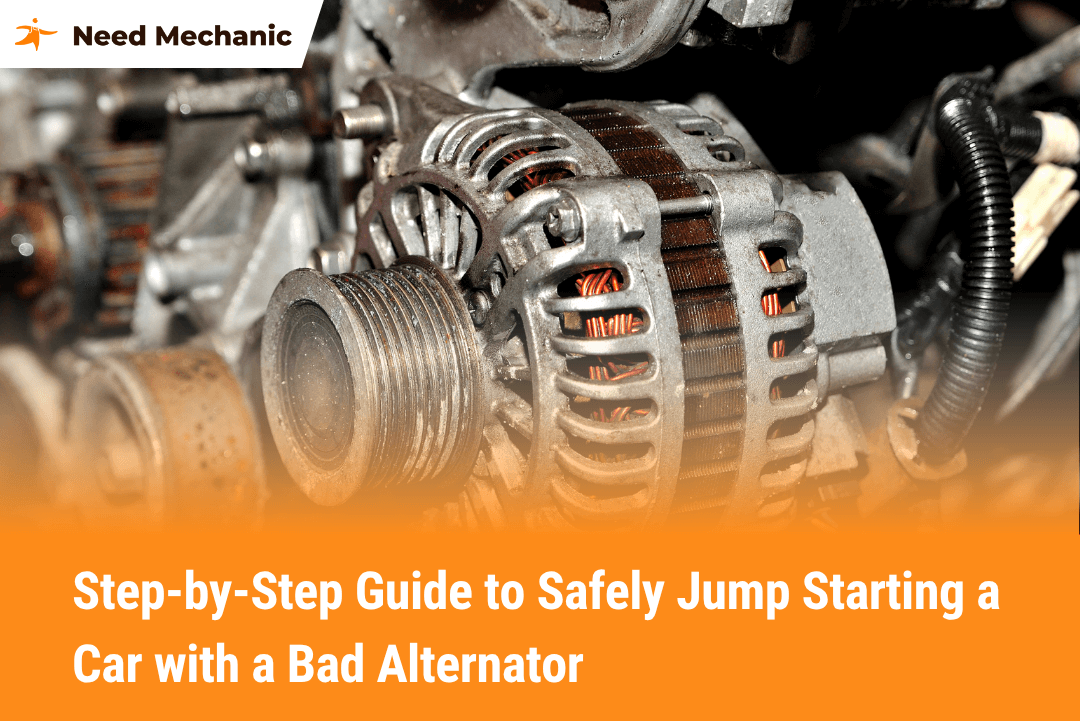Yes, you can jump start a car with a bad alternator but only as a temporary fix to get you to safety or a repair shop. The alternator’s job is to keep your battery charged while the engine is running, and when it fails, your car relies entirely on the battery’s stored energy. That means even after a jump, your vehicle will run only until the battery drains again, sometimes in as little as 15–30 minutes.
In this guide, we’ll explain exactly how to jump start a car with a bad alternator safely, how far you can expect to drive, what tools and precautions you need, and how to avoid damaging your battery or getting stranded. We’ll also cover warning signs of alternator trouble so you can spot problems early and prevent emergencies. By the end, you’ll know the right steps to take in the moment and how to fix the root cause for good.
Table of Contents
- How the Alternator Works and Why It Matters
- Signs of a Bad Alternator
- Can You Jump Start a Car with a Bad Alternator?
- Step-by-Step: How to Safely Jump Start a Car with a Bad Alternator
- Safety Tips When Jump Starting with a Bad Alternator
- Risks of Driving on a Bad Alternator After a Jump Start
- What to Do After Jump Starting with a Bad Alternator
- How to Prevent Alternator-Related Breakdowns in the Future
- Final Thoughts: Act Fast to Avoid Bigger Problems
- FAQs
How the Alternator Works and Why It Matters
The alternator is a small but powerful component that converts mechanical energy from your engine into electricity. It does three essential things:
- Keeps the battery charged while you drive.
- Powers electrical systems such as headlights, dashboard instruments, and infotainment systems.
- Supports accessories like power windows, heated seats, and air conditioning.
When the alternator fails, your battery is forced to carry the entire electrical load. This means that even after a jump start, your car will only run until the battery’s stored energy is depleted. In many cases, this can be as short as 15–30 minutes of driving, depending on the battery’s health and electrical demands.
Signs of a Bad Alternator
Knowing whether you’re dealing with a bad alternator or just a weak battery is critical before deciding to jump start. Common signs include:
- Dim or flickering headlights when the car is running.
- Battery warning light glowing on your dashboard.
- Electrical issues such as malfunctioning radio, power windows, or gauges.
- Engine stalling or struggling to stay running.
- Unusual noises like whining or grinding from the engine bay.
- Burning smell from overheated wiring or belt slippage.
If you experience several of these symptoms together, your alternator is likely failing or already dead.
Can You Jump Start a Car with a Bad Alternator?
Yes, you can jump start a car with a bad alternator but you must understand the limitations. A jump start simply boosts your battery with power from another vehicle or jump starter pack. Once the donor power is disconnected, your battery is on its own.
If the alternator isn’t working, the battery will drain again quickly because no new power is being generated. Think of it like filling a leaking bucket—your car will run for a short time, but the “leak” (the failed alternator) will drain it again.
This means that jump starting is only a way to get the car to a safe location or repair shop, not a permanent fix.
Step-by-Step: How to Safely Jump Start a Car with a Bad Alternator
1. Gather the Right Tools
- Jumper cables in good condition (no frayed wires).
- Another vehicle with a working battery (or a portable jump starter).
- Safety gloves and eye protection.
2. Park and Prepare
Position both vehicles close enough so the jumper cables reach, but do not let the cars touch. Turn off both engines, set the parking brakes, and make sure both cars are in Park (automatic) or Neutral (manual).
3. Connect the Cables in the Correct Order
- Red to dead – Attach the red cable clamp to the positive terminal (+) on your dead battery.
- Red to donor – Attach the other red clamp to the positive terminal on the working battery.
- Black to donor – Attach the black cable clamp to the negative terminal (–) of the working battery.
- Black to metal – Attach the final black clamp to an unpainted metal surface on the car with the dead battery (away from the battery itself) to reduce spark risk.
4. Start the Donor Vehicle
Run the working car for a few minutes to allow the dead battery to gain some initial charge.
5. Start the Car with the Bad Alternator
Try starting your vehicle. If it starts, keep it running and immediately head toward your repair destination. Avoid unnecessary stops, as restarting the car may be impossible once the battery drains again.
6. Disconnect in Reverse Order
When ready, remove the cables in the reverse order of connection:
- Black from metal
- Black from donor battery
- Red from donor battery
- Red from your battery
Safety Tips When Jump Starting with a Bad Alternator
- Limit driving time—aim for the shortest route to your repair shop.
- Turn off non-essential electronics like radio, AC, and heated seats to preserve battery life.
- Avoid night driving if possible, as headlights will drain the battery faster.
- Don’t keep trying to start the car repeatedly; excessive cranking can damage the battery further.
- Stay alert—if your dashboard lights start dimming again, pull over safely before the engine stalls.
Risks of Driving on a Bad Alternator After a Jump Start
Jump starting will not damage your vehicle in most cases, but driving with a bad alternator poses real risks:
- Total power loss while driving—which can disable steering assist, braking assist, and lights.
- Stranded in unsafe locations if the battery drains unexpectedly.
- Damage to the battery from deep discharge cycles.
- Potential harm to electronic systems if voltage drops too low.
This is why a jump start should be treated as an emergency measure only.
What to Do After Jump Starting with a Bad Alternator
Once you’ve successfully jump started and reached a safe place:
- Test the alternator – A mechanic can check if it’s truly failed using a voltmeter.
- Replace the alternator promptly – Driving without a functional alternator is not sustainable.
- Check the battery’s health – Prolonged low voltage can damage the battery, requiring replacement.
- Inspect the drive belt – Sometimes alternator issues stem from a worn or loose belt rather than the alternator itself.
How to Prevent Alternator-Related Breakdowns in the Future
- Regular maintenance checks – Have your charging system inspected during oil changes.
- Replace worn belts before they fail.
- Watch for early warning signs like dim lights or battery warning lights.
- Avoid overloading the electrical system with too many aftermarket accessories.
By catching alternator problems early, you can avoid sudden breakdowns and costly towing bills.
Final Thoughts: Act Fast to Avoid Bigger Problems
Jump starting a car with a bad alternator can get you out of an immediate jam, but it’s not a long-term solution. The moment you get your vehicle running, you should focus on getting the alternator replaced and ensuring your battery is in good health.
By understanding how the alternator works, recognizing warning signs early, and following safe jump start procedures, you can handle emergencies with confidence. Most importantly, quick action will save you from being stranded in a dangerous or inconvenient place.If you take one thing away from this article, it’s this: a jump start buys you time, not a fix—so use that time wisely and head straight for repairs.
FAQs
How far can I drive after jump starting a car with a bad alternator?
Usually only 15–30 minutes, depending on your battery’s health and how many electrical systems you use while driving.
Can a bad alternator drain a battery overnight?
Yes. If the alternator has an internal fault, it can pull power from the battery even when the car is off.
Will a portable jump starter work on a car with a bad alternator?
Yes, but it’s still only a temporary solution. Your car will still stop running once the battery drains again.
How much does it cost to replace an alternator?
The cost typically ranges from $300 to $800 or more, depending on your vehicle type and labor rates.
Is it safe to drive with a weak alternator?
It’s risky. A weak alternator can fail at any time, causing your car to lose all power while driving.
Could my problem be just the battery and not the alternator?
Yes. Both parts should be tested to confirm which one is faulty before replacing anything.
Can a bad alternator cause the car to stall while driving?
Absolutely. If the battery loses power, essential systems like ignition and fuel injection will stop working.





Leave a Reply